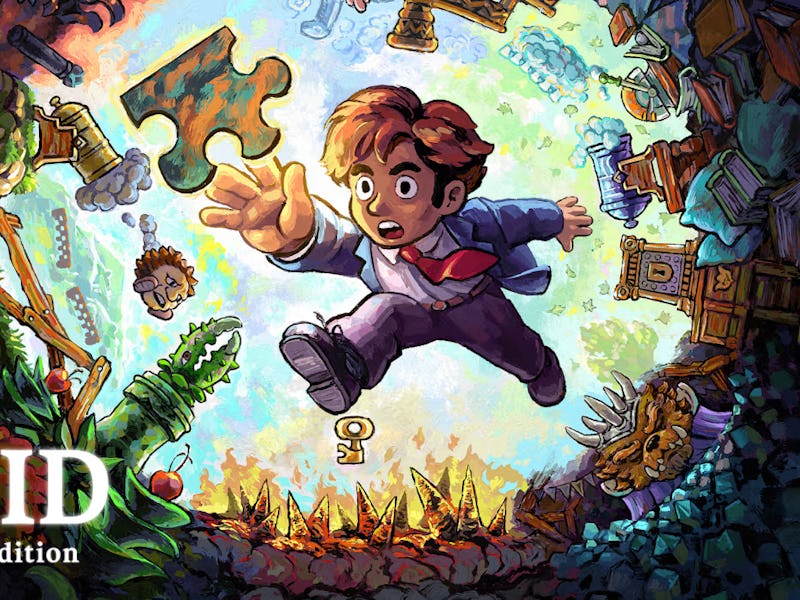16 Years Later, Braid: Anniversary Edition’s Inventive Puzzles Humbled Me
The redux of this seminal indie classic reminds players why it was such a big deal in the first place.

When the original Braid was released in 2008, it greatly changed my perception of what video games could be. The novelty of bite-sized video games was still an exciting frontier for console gamers like myself, as we were still months away from the likes of the first Geometry Wars, PixelJunk Monsters on PlayStation, and Valve’s Portal.
Promotional videos on Xbox Live made Braid look like a weird Super Mario clone with Prince Of Persia: The Sands Of Time mechanics. What I got was so much more intriguing: a twisted peak into a failed relationship, steeped in metaphor that seemed super poignant for a 15-year-old obsessed with the possibilities of storytelling in video games. I spent countless late nights tracking down every puzzle piece in the game, a feat I accomplished in just a couple of weeks.
So when I booted up Braid: Anniversary Edition, a remastered redux debuting a few months ahead of its 16th anniversary, I went into it full of smug confidence. After all, I’d beaten Braid when I was half my current age, long before I became a seasoned lover of puzzle games. Hell, I even made a respectable amount of progress in The Witness, the notoriously obtuse follow-up to Braid.
Braid was one of gaming’s first indie successes when it was released in 2008.
To my surprise, I was quickly humbled by the puzzle platformer all these years later. Even the most basic puzzles presented in Braid’s opening hours had me putting down the controller and sketching rudimentary pictures to help wrap my head around its complex time mechanics. In a matter of minutes, I was sucked back into overcoming this painterly, surreal journey, reminding me what made this game so special in the first place.
Braid follows Tim, a red-headed little guy trying to rescue a princess. Players peek into Tim’s mind through text entries before each of the game’s six worlds. Each world introduces a new time mechanic, which combined with your ability to rewind time, becomes the crux of solving its puzzles and progressing to its grand finale.
The Anniversary Edition adds new puzzles, new, hand-painted visuals, and animations that look great on 4K displays, rerecorded audio, and more than 12 hours of commentary from the game’s creator Jonathan Blow.
The added commentary tracks from designer Jonathon Blow sweeten the deal of the game’s Anniversary Edition.
When Braid originally came out, it was the second game ever to headline Xbox’s new “Summer Of Arcade,” an annual promotional program highlighting otherwise obscure indie projects and smaller titles from big publishers like Capcom and Konami. For six years, the program ushered the debut of some of the most influential indie games ever released and is a distant memory of a time when the future of the Xbox brand seemed a little brighter than it does these days, given recent studio closures. Braid was one of the major successes that helped solidify smaller games as mainstays on the Xbox 360 and PS3.
I’m pleased to report that time has been very kind to Braid. The sheen on its mechanics shines as bright as it did 15 years ago. Its blend of time and environmental manipulation makes this game deceptively complex juxtaposed to its basic Super Mario Bros aesthetics. The fact that it's been 15 years since its release means running through this one again is like experiencing a brand-new game. I was enraptured by how inventive and clever every puzzle is. Like so many of the games that it influenced, like the recent Animal Well, Braid expertly uses perspective and organic player discovery to string the player along instead of overt signposting.
The added commentary tracks are yet another powerful example of how to provide insight into how games are made. They are easily accessible and blend well into gameplay thanks to the seamlessness of the audio tracks and videos that overlay gameplay with the pull of the trigger. They provide insightful context for how one designs such a conundrum-inducing title like this one. For fans of Blow’s aforementioned follow-up, The Witness, it is also interesting to see how the game designer extrapolated parts of his original hit to craft his 2016 magnum opus.
Braid often plays on recognizable video game tropes throughout its five-hour runtime.
The Anniversary Edition isn’t a complete home run, however. Braid’s once-revelatory story falls a little flat compared to its timeless mechanics. Without the context of this being one of the earliest indie games to hit the mainstream, this shortcoming can be forgiven. But in gaming’s current landscape where titles like Celeste, Venba, and the recent Tales Of Kenzera: Zau have set new standards for games tackling mature and difficult themes, Braid can feel less effective at best, and pretentious at worst, particularly for players who remember the big plot points throughout its five-hour runtime.
Still, Braid: Anniversary Edition is well worth the $20 asking price. I admit, I was initially a little skeptical of why I’d want to replay Braid so long after its release. The original game still looks decent enough and is readily available on virtually all platforms. But jumping back into this classic quickly taught me that this souped-up version isn’t just a neat history lesson for youngsters who’ve never played it before. It’s a timeless classic that holds up for players who haven’t touched this indie classic in years.
Braid: Anniversary Edition is available on the Nintendo Switch, Xbox Series X|S, PlayStation 5, and Steam.